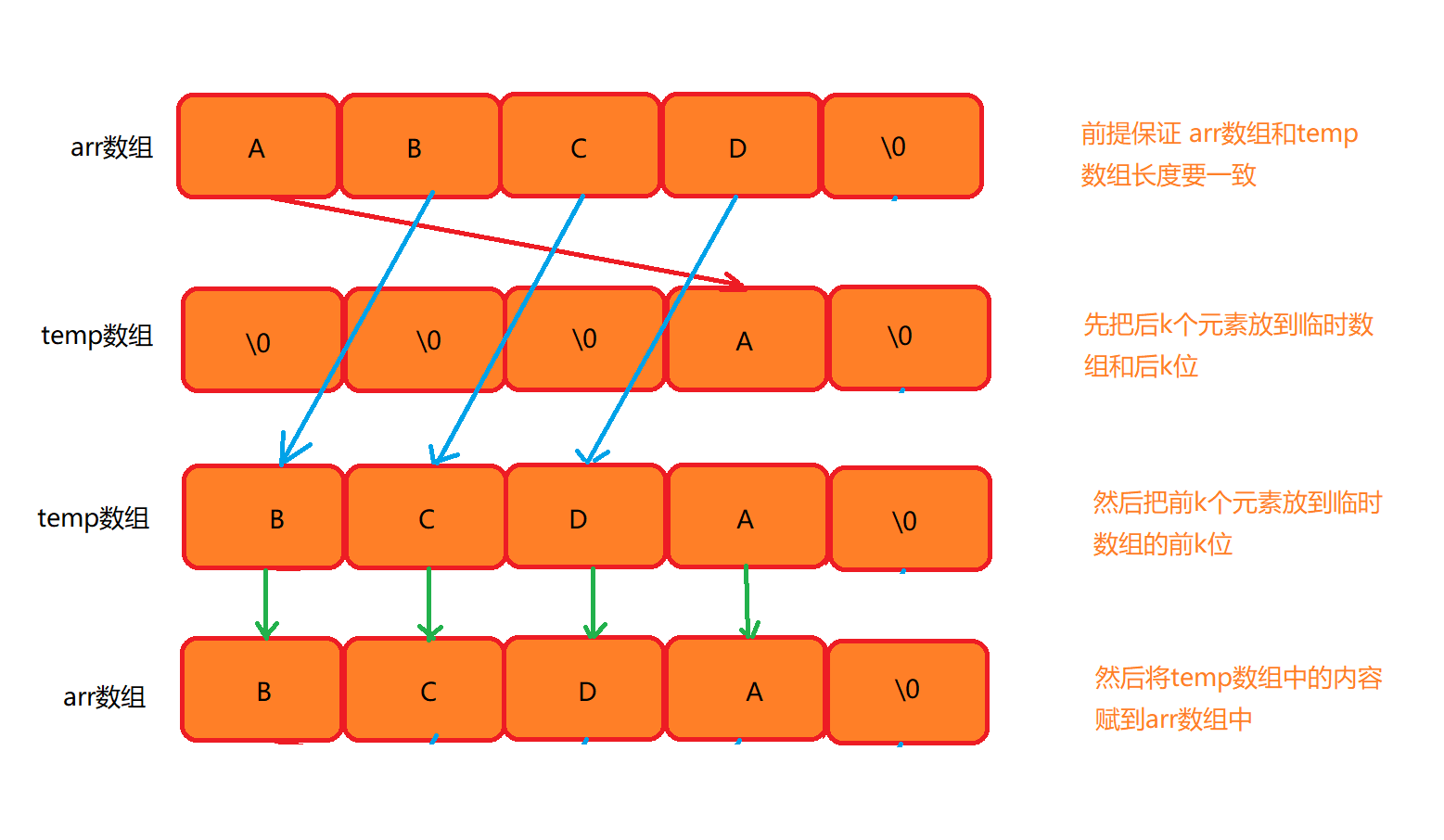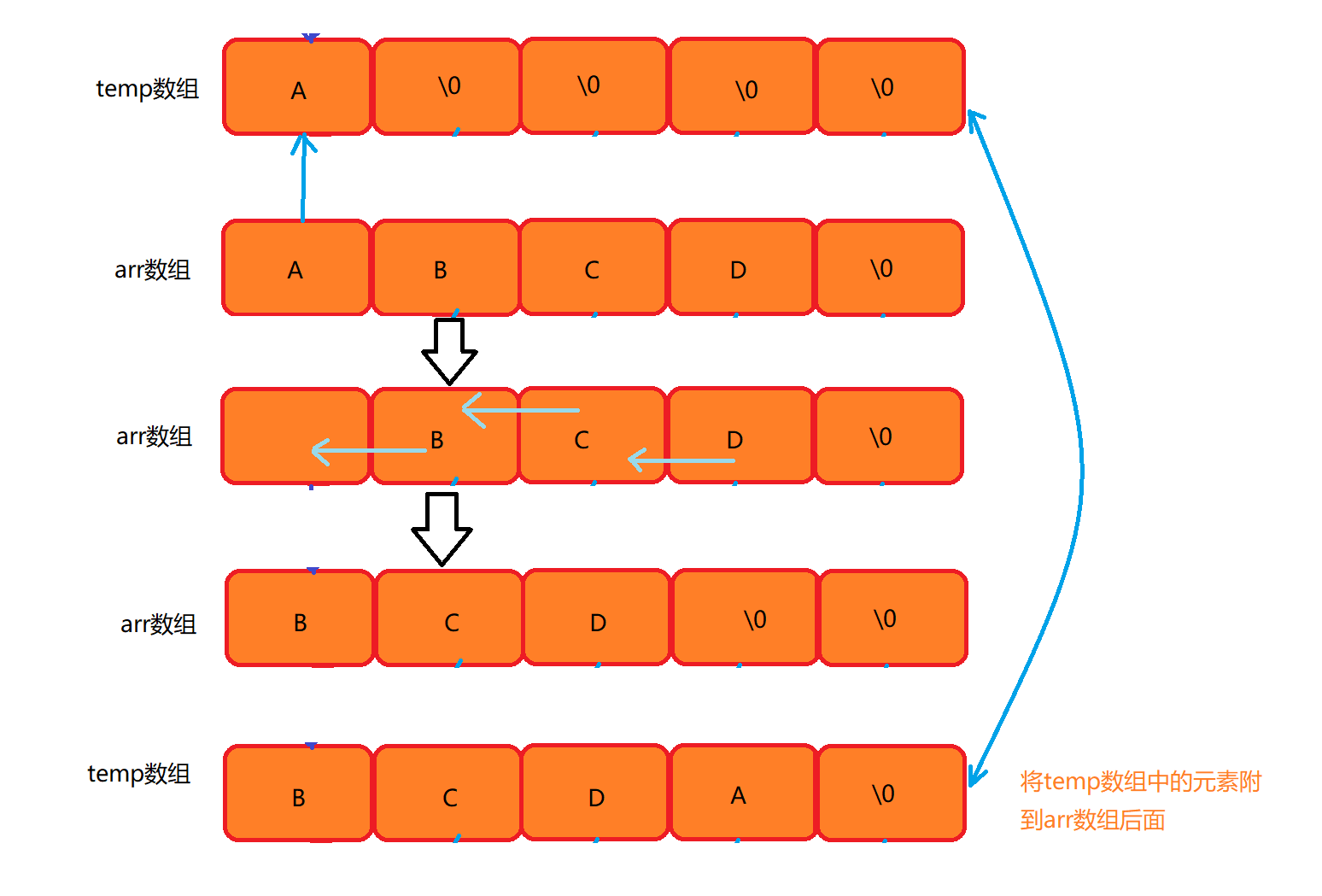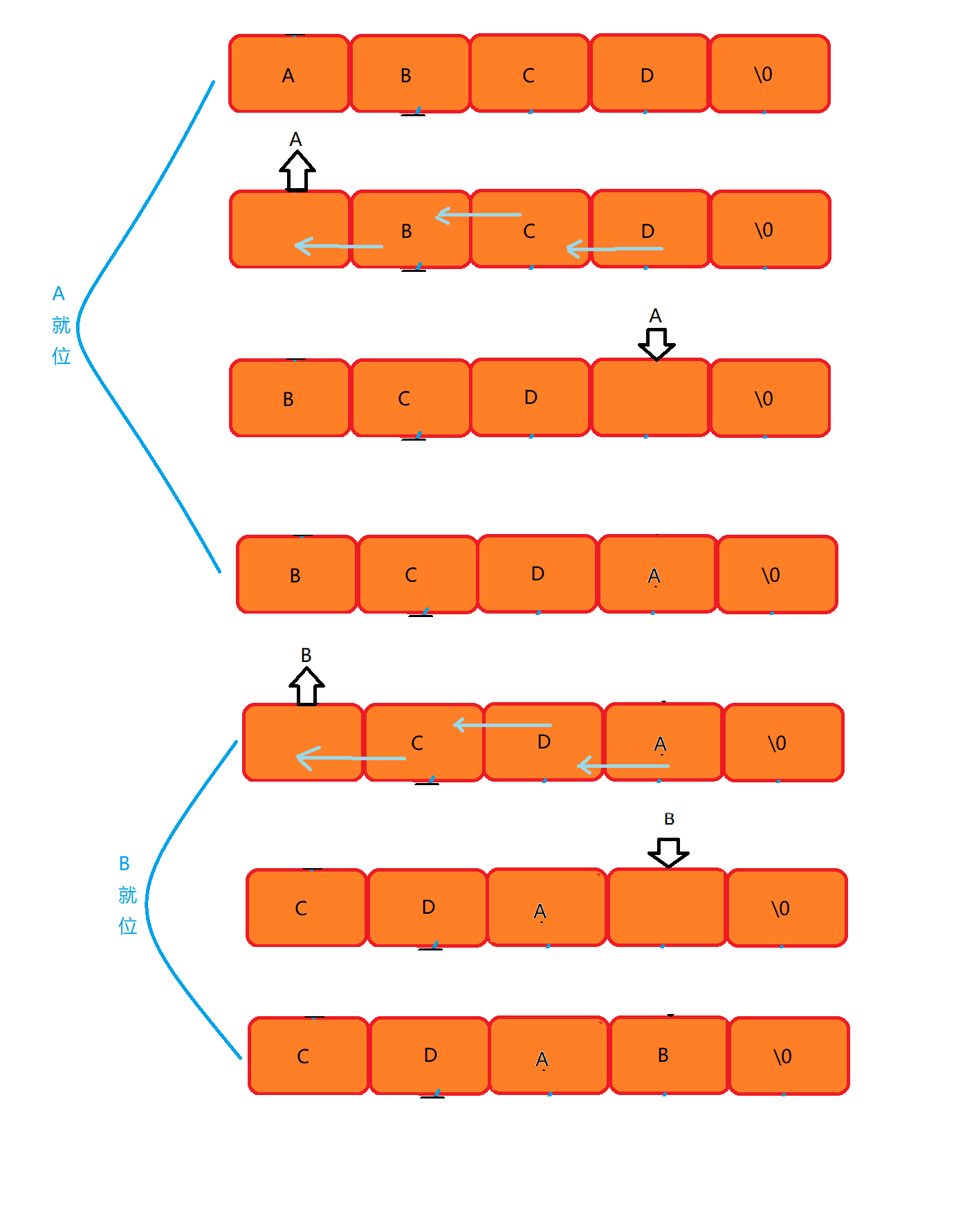Introduction to the content of the title (left-handed transport operator)
Implement a function that can k characters in a left-handed string.
ABCD left turns one character to get BCDA
ABCD left rotation two characters to get CDAB
Idea 1: temporary array method 1
-
Array arr the contents of the array should be moved forward by K bits, and the first k moves to the end of the ARR array.
-
First, create a temporary array temp with the same length as the original array arr.
-
Assign the first k elements in the arr array to the last k bits of the temp array.
-
Then shift the first k of the arr array to the first k of the temp array. In this way, the rotated element order is presented in the temp array.
-
Then assign the overall content of the temp array to the original array arr.
Related diagrams

code implementation
#include <stdio.h>
#include <string.h>
#include <assert.h>
void rotate(char* arr, int len, int k)
{
assert(arr != NULL); //Array length cannot be empty
assert(k <= len); //The passed k must be less than the length of the array
char temp[5] = { 0 };
int i = 0;
//Move the first k bits of the arr array to the last k bits of the temporary array
for (i = 0; i < k; i++)
{
temp[len - k + i] = arr[i];
}
//Move the last k bits of the arr array to the first k bits of the temporary array
for (i = k; i < len; i++)
{
temp[i - k] = arr[i];
}
//Move the contents of temp array to arr array
for (i = 0; i < len; i++)
{
arr[i] = temp[i];
}
}
int main()
{
//First assign the first k characters in arr to the back of temp, and then move the last few bits of K in arr to the first few bits of temp
char arr[] = "ABCD";
int len = strlen(arr);
int k = 0;
scanf("%d", &k); //Number of digits moved forward
rotate(arr, len, k);
printf("%s", arr);
return 0;
}
Idea 2: temporary array method 2
-
Create a temporary array
-
Transfer the first k bits (including k bits) of the arr array to the array first.
-
The position of the first k bits (including k bits) of the arr array has been vacant at this time. Move the last k bits in the arr array forward by K bits
-
Then attach the contents of the temporary array to the back of the arr array
Relevant diagrams:

Code implementation:
#include <stdio.h>
#include <string.h>
#include <assert.h>
void rotate(char* arr, int len, int k)
{
assert(arr != NULL); //The array passed in cannot be empty
assert(k <= len); //The number of rotations passed in must be less than or equal to the character length
char temp[5] = { 0 }; //Create a temporary array,
int i = 0;
//Use a temporary array to store the elements in the first k arr arrays
for (i = 0; i < len; i++)
{
temp[i] = arr[i];
}
//Then move the elements in the array left by arr forward by k bits
for (i = k; i < len; i++)
{
arr[i - k] = arr[i];
}
//Insert the numbers in the temporary array into the arr array
for (i = len - k ; i < len; i++)
{
arr[i] = temp[i - (len - k)];
}
}
int main()
{
char arr[] = "ABCD";
int len = strlen(arr); //Calculate string length
int k = 0;
scanf("%d", &k); //Turn k characters to do first
rotate(arr, len,k);
printf("%s", arr);
return 0;
}
Idea 3: temporary variable circulation method
- The above two algorithms have the same defect, that is to establish a temporary array and limit the length of the temporary array, which seriously affects the flexibility of the algorithm and improves the spatial complexity,
- The following is the third algorithm, which reduces the spatial complexity
- Extract the first k elements from the arr array one at a time
- In the process of extraction, move the last k elements forward
- Add the extracted elements to the arr array in turn
Relevant diagrams:

Code implementation:
#include <stdio.h>
#include <string.h>
#include <assert.h>
void rotate(char* arr, int len, int k)
{
assert(arr != NULL);
assert(k <= len);
int i = 0;
for (i = 0; i < k; i++)
{
char temp = arr[0];
int j = 0;
for (j = 0; j < len-1; j++)
{
arr[j] = arr[j + 1];
}
arr[len - 1] = temp;
}
}
int main()
{
char arr[] = "ABCDE";
int k = 0;
scanf("%d", &k);//Number of digits to move
int len = strlen(arr);
rotate(arr, len, k);
printf("%s", arr);
return 0;
}
Idea 4: block transformation (inversion)
- The first two algorithms improve the spatial complexity but reduce the time complexity
- The third algorithm improves the time complexity but reduces the space complexity
- In the end, there is an algorithm with relatively low space and time complexity. That must be a drop!
- Step 1: flip the first k characters in pairs.
- Step 2: flip the last k (including k) characters.
- Step 3: flip the whole character.
Relevant diagrams:

Code implementation:
```c
#include <stdio.h>
#include <string.h>
#include <assert.h>
void reverse(char* left,char* right)
{
while (left < right)
{
char temp = 0;
temp = *left;
*left = *right;
*right = temp;
left++;
right--;
}
}
void rotate(char* arr, int len, int k)
{
assert(arr != NULL); //The string array passed cannot be empty
assert(k <= len); //The number of moving bits passed must be less than the length of the string
//Rotate the first k elements
reverse(arr, arr + k - 1);
//K (including k) elements after rotation
reverse(arr + k , arr + len - 1);
//Rotate whole element
reverse(arr, arr + len - 1);
}
int main()
{
char arr[] = "ABCD";
int k = 0;
scanf("%d", &k);//Rotate the character to the left by k bits
int len = strlen(arr); //Character length
rotate(arr, len, k);
printf("%s", arr);
return 0;
}